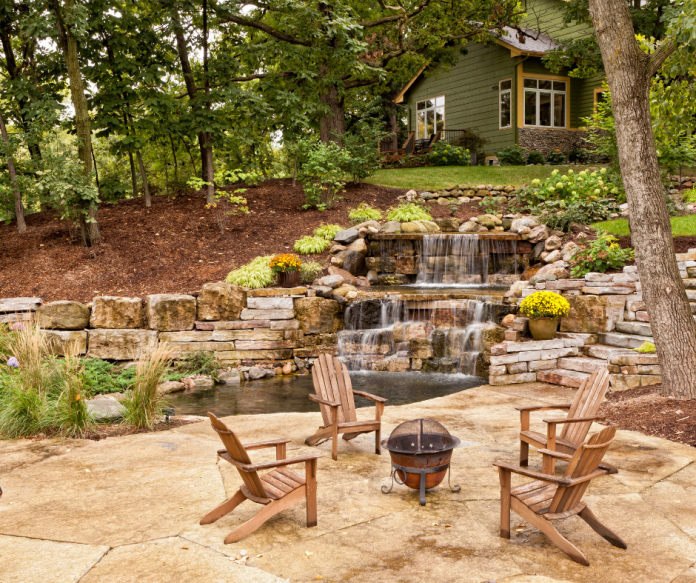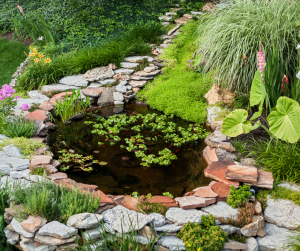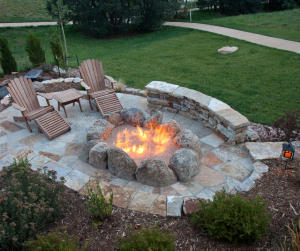
Landscaping with rocks can bring home and hobby together and help us to feel connected with our surroundings. Many collectors have larger stones and specimen stones that can add practical function or aesthetic beauty. The trick is to inventory what you’ve got and then decide how to use it. Here are some tips for inspiration.
Practical Stones
 Stone is valued for its year-round interest and unique appearance. It’s also low to no maintenance. It can withstand weather and heavy use, essentially indefinitely, depending on the material chosen.
Stone is valued for its year-round interest and unique appearance. It’s also low to no maintenance. It can withstand weather and heavy use, essentially indefinitely, depending on the material chosen.
Rocks and stones can be used for patios, walls, stairs or even be incorporated into exterior lighting. Stone is also used extensively for drainage and to protect against erosion.
Walls & Steps
Walls are an important part of the landscape to contend with differing elevations and serve as a barrier to hold the earth in place. Stone walls may be formal or informal. Stone walls can also serve to mark property boundaries or to protect an area such as a garden or a swimming pool.
Stone steps often accompany a rock wall, but not always. Stone stairs are frequently used for their durability, as well as their appearance. They can be uniform and clean looking, or erratic and uneven.
Stone walls and stairs often serve double duty as exterior seating. Stone pillars may flank either stairs or walls and sometimes incorporate landscape lighting elements.
Drainage & Protection
Stone is the building material of choice for wet or poorly drained areas. Water drains more quickly through small rocks than clay or muck soils. Gardens can be built on top of a bed of gravel to aid in drainage. For areas that lose soil during rain or weather events, stone serves as a solid barrier to prevent or reduce such losses.
 In their role as a protector, rocks also shield plants from many types of stress. Plants growing directly behind or next to rocks are less likely to be trampled. Rocks provide shade in the summertime and absorb some of the heat that would have otherwise gone into the soil to the plant’s root zone. In colder months, stone helps to insulate and shield plants from the worst of winter’s freezing winds.
In their role as a protector, rocks also shield plants from many types of stress. Plants growing directly behind or next to rocks are less likely to be trampled. Rocks provide shade in the summertime and absorb some of the heat that would have otherwise gone into the soil to the plant’s root zone. In colder months, stone helps to insulate and shield plants from the worst of winter’s freezing winds.
Aesthetic Stones
Some of the most beautiful elements of the landscape are constructed of stone. Stone is an amazing medium for statement pieces and works of art. Just like lapidary artists with jewelry, skilled artisans, can utilize stone to create a focal point, an impact, a separation or an aesthetic element to a water or fire feature.
Stone elements can also draw your eye away from less attractive or utilitarian features in the landscape such as drainage elements or buildings. Stone or rocks of varying sizes can be combined to create contrast. They can be the backdrop for living elements such as flowers or uniquely shaped trees. They can be used to create an entire garden or as an accent anchor or as a centerpiece.
Boundaries & Landscape Features
Separation in the yard or garden can be achieved with many materials, both natural and synthetic. None, however, have quite the impact of stone. Stone can be used to define boundaries of gardens, properties or just to delineate one type of land use from another.
Rocks can also be the basis of landscape features containing other elements such as water or fire. Entire features can be cleverly built out of or carved from stone. A recess in a large rock can be carved out to create a fire pit for outdoor ambiance and cooking. Elaborate waterfalls can be built with well-sited and selected boulders and large rocks. Ponds can be lined, encircled with, or be made entirely from rock. On a smaller scale, birdbaths, footpaths, or cooling stations for wandering animals can be carved out of the right stone and contribute to the aesthetics of a landscape.
Making a Statement
 Even without extensive skills in sculpting or masonry, stone can be a statement unto itself. The mere placement of a large boulder in the landscape can go a long way to adding dimension and depth to an otherwise ordinary yard. While it can be costly to add large, statement-type boulders or to convert large portions of the landscape to stone or rock, there are some more cost-effective ways to incorporate stone into your landscape.
Even without extensive skills in sculpting or masonry, stone can be a statement unto itself. The mere placement of a large boulder in the landscape can go a long way to adding dimension and depth to an otherwise ordinary yard. While it can be costly to add large, statement-type boulders or to convert large portions of the landscape to stone or rock, there are some more cost-effective ways to incorporate stone into your landscape.
Where to Get Landscaping Stones
If stones are not native to your home landscape and easily dug, then there are other options. Leftovers from construction sites are often locations to obtain free materials with permission from the site owner. Materials that people would have to pay to discard are often gladly given away for free. Permission can sometimes be obtained from public lands to take some rock out so long as it is not serving another deliberate or ecological function. Failing the free options, rock and stone are available in all shapes, sizes and prices at many garden and landscape supply stores.
Environmental Concerns to Using Stone
You have decided that your outdoor living space needs more natural elements and stone is the perfect addition. It comes from nature, so there must be very little environmental impact in using it, right? Well, not exactly. Stone for landscape use is either removed from natural settings like riverbeds, dug or quarried. Each harvesting and transportation method utilizes fossil fuels. The closer from the point of origin to its destination, the lower the carbon footprint to getting it there.
Quarrying operations can damage the environment. Many responsible companies do have reclamation plans in place for when an area has been tapped out. It is important to work with a company that has such a plan in place. It’s also good to work with a company that doesn’t quarry stone or rock that is in short supply or that is ecologically sensitive.
The process of extracting or processing stone for use in decoration or industry creates other problems as well. Besides erosion and fossil fuel usage, these processes create noise pollution and often generate dust that travels far from its point of origin. This doesn’t mean that stone should be ruled out as a function of the landscape. Because stone does not decompose, there are often many opportunities to reuse stone that has already been quarried or used for other purposes. There are also landscape companies that take their role very seriously and work to offset any disturbances they cause by improving the environment in other ways such as planting more trees or even just by using more environmentally-friendly extraction methods to obtain the stone.
Famous Examples of Landscaping Stones
Mankind has been altering and shaping stone for a variety of purposes since the first primitive hand tools were fashioned. There are thousands of examples all over the world. Here is a list of some of the better-known examples.
NORTH AMERICA
Cairns – Cairns can be found all over North America but most often near coasts. They are simply stones piled atop one another but can be made up of many thousands. Examples date back many hundreds of years.
Public gardens – We are fortunate to have many examples of 19th and 20th-century landscape architecture to visit. In some cases, renowned landscape architects designed magnificent stone structures for their wealthy clients and are now available for all to see. One such example is the grand stone staircase at Naumkeag in Massachusetts designed by Fletcher Steele.
Monuments – Whether carved in place such as Mount Rushmore or the Crazy Horse monuments in South Dakota or sited at a specific spot such as the MLK Jr. memorial in Washington D.C., stone is the perfect material to honor our history.
Public Art Displays – These come in all sizes and can be found in almost every town, city or county. They can be as simple as a painted rock in a town square or an array such as America’s Stonehenge in Georgia.

Arian Zwegers is licensed under CC BY 2.0
AROUND THE WORLD
Ancient Stone Monuments – Historic peoples have baffled generations with their ingenuity in moving stones weighing many tons without the aid of machinery. Sites like Stonehenge, Easter Island, or the Great Pyramids of Giza still elicit awe for their sheer scale.
Public Gardens – The world abounds in fine examples of masonry and ornate stonework in public gardens such as those found in Japan and England.
Great Wall of China – This gargantuan feat of engineering needs no introduction. Once erroneously thought to be the only manmade structure to be seen from space (it’s not), this amazing landmark was started over 2200 years ago!
This story about landscaping with rocks previously appeared in Rock & Gem magazine. Click here to subscribe! Story by Chris Bond.














